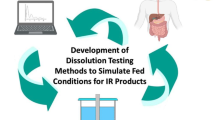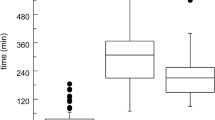ABSTRACT
Purpose
There are several endogenous and exogenous species in the gastrointestinal (GI) tract which can act as solubilizing agents and thereby affect drug dissolution. The purpose of this study is to understand food effects on drug dissolution and provide insight into their anticipated overall effect on absorption and bioavailability.
Methods
Dissolution kinetics of 15 drugs of variable logP, charge, and molecular weight were tested in simulated intestinal environment. The ability of a film-equilibrium-based model to predict the influence of a simulated intestinal environment on drug dissolution was examined.
Results
The most significant improvement in dissolution kinetics and solubility (up to 6-fold) was evident with highly hydrophobic compounds (logP > 4). Improvement in solubility did not always constitute improvement in dissolution kinetics on a relevant time scale. Comparison of simulation and experimental results indicates that a model considering micelle partitioning as a pseudo-equilibrium process can predict trends in the influence of food-related solubilizing agents on drug dissolution kinetics.
Conclusions
The significance of food-related solubilizing agents to drug dissolution is not always obvious, as it depends on multiple physicochemical parameters; however, simple modeling may provide insight into food effects on dissolution and, ultimately, overall absorption and bioavailability of compounds considered for oral formulation.






Similar content being viewed by others
REFERENCES
Lipinski CA, Lombardo F, Dominy BW, Feeney PJ. Experimental and computational approaches to estimate solubility and permeability in drug discovery and development settings. Adv Drug Deliv Rev. 2001;46(1–3):3–26.
Dressman JB, Amidon GL, Reppas C, Shah VP. Dissolution testing as a prognostic tool for oral drug absorption: immediate release dosage forms. Pharm Res. 1998;15(1):11–22.
Porter CJH, Trevaskis NL, Charman WN. Lipids and lipid-based formulations: optimizing the oral delivery of lipophilic drugs. Nat Rev Drug Discov. 2007;6(3):231–48.
Lentz KA. Current methods for predicting human food effect. AAPS J. 2008;10(2):282–8.
Agoram B, Woltosz WS, Bolger MB. Predicting the impact of physiological and biochemical processes on drug bioavailability. Adv Drug Deliv Rev. 2001;(50)S41–S67.
Oh DM, Curl RL, Amidon GL. Estimating the fraction dose absorbed from suspensions of poorly soluble compounds in humans: a mathematical model. Pharm Res. 1993;10(2):264–70.
Sinko PJ, Leesman GD, Amidon GL. Predicting fraction dose absorbed in humans using a macroscopic mass balance approach. Pharm Res. 1991;8(8):979–88.
Takano R, Sugano K, Higashida A, hayashi Y, Machida M, Aso Y, et al. Oral absorption of poorly soluble water-soluble drugs:computer simulation of fraction absorbed in humans from a miniscale dissolution test. Pharm Res. 2006;23(6):1144–56.
Yu LX, Lipka E, Crison JR, Amidon GL. Transport approaches to the biopharmaceutical design of oral drug delivery systems: prediction of intestinal absorption. Adv Drug Deliv Rev. 1996;19(3):359–76.
Willmann S, Solodenko J, Sevestre M, Lippert J, Schmitt W. A pharmacodynamic extension for the physiology-based pharmacokinetic whole-body model PK-Sim((R)). Eur J Pharm Sci. 2004;23:S75–5.
Jamei M, Marciniak S, Feng KR, Barnett A, Tucker G, Rostami-Hodjegan A. The simcyp (R) population-based ADME simulator. Expert Opin Drug Metab Toxicol. 2009;5(2):211–23.
www.simulations-plus.com, 2009.
Higuchi WI. Effects of interacting colloids on transport rates. J Pharm Sci. 1964;53:532–5.
Gamsiz ED, Miller L, Thombre AG, Ahmed I, Carrier RL. Modeling the influence of cyclodextrins on oral absorption of low-solubility drugs: I. Model development. Biotechnol Bioeng. 2010;105(2):409–20.
Jantratid E, Janssen N, Reppas C, Dressman JB. Dissolution media simulating conditions in the proximal human gastrointestinal tract: an update. Pharm Res. 2008;25(7):1663–76.
Amidon GE, Higuchi WI, Ho NF. Theoretical and experimental studies of transport of micelle-solubilized solutes. J Pharm Sci. 1982;71(1):77–84.
Crison JR, Shah VP, Skelly JP, Amidon GL. Drug dissolution into micellar solutions: development of a convective diffusion model and comparison to the film equilibrium model with application to surfactant-facilitated dissolution of carbamazepine. J Pharm Sci. 1996;85(9):1005–11.
Okazaki A, Mano T, Sugano K. Theoretical dissolution model of poly-disperse drug particles in biorelevant media. J Pharm Sci. 2008;97(5):1843–52.
Swarbrick J. Encyclopedia of pharmaceutical technology. New York: Informa Healthcare, Inc; 2003.
Li J, Carr PW. Accuracy of emprical correlations for estimating diffusion coefficients in aqueous organic mixtures. Anal Chem. 1997;69(13):2530–6.
Besler HT. Proteins in food processing. In: Yada R, editor. 2005.
Persson EM, Gustafsson A-S, Carlsson AS, Nilsson RG, Knutson L, Forsell P, et al. The effects of food on the dissolution of poorly soluble drugs in human and in model small intestinal fluids. Pharm Res. 2005;22(12):2141–51.
ACKNOWLEDGEMENTS
The authors would like to thank to Simulations Plus, Inc., Lancaster, CA for financial support and Dr. Robert Campbell from the department of Pharmaceutical Sciences at Northeastern University for particle size measurements.
Author information
Authors and Affiliations
Corresponding author
Rights and permissions
About this article
Cite this article
Gamsiz, E.D., Ashtikar, M., Crison, J. et al. Predicting the Effect of Fed-State Intestinal Contents on Drug Dissolution. Pharm Res 27, 2646–2656 (2010). https://doi.org/10.1007/s11095-010-0264-x
Received:
Accepted:
Published:
Issue Date:
DOI: https://doi.org/10.1007/s11095-010-0264-x




